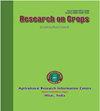生长阶段对红豆杉叶粉营养价值的影响
Q3 Agricultural and Biological Sciences
引用次数: 0
摘要
大多数非洲叶菜(ALV)的营养矿物质元素浓度受植物生长阶段的影响。Momordica balsamina 是葫芦科的一种叶菜,具有丰富的营养和药用价值,可在植物的不同生长阶段获得。一项温室研究旨在确定在不同生长阶段采收的毛地黄叶菜的营养价值反应。六个生长阶段,即无性繁殖期(参照期)、花蕾发育期、始花期、坐果期、果实发育期和生理成熟期作为处理,共 10 次重复,按 RCBD 排列。各处理对钾 (K)、钙 (Ca)、镁 (Mg)、锌 (Zn)、铁 (Fe) 和磷 (P) 等营养品质的影响非常显著(P ≤ 0.01)。与参考值相比,钾的最高含量(1206 毫克/升)出现在始花期,而钙(127.70 毫克/升)和锌(2.21 毫克/升)的最高含量出现在果实发育期。在生理成熟阶段,镁(25.19 毫克/升)、磷(16.54 毫克/升)和铁(5.49 毫克/升)的浓度最高。值得注意的是,在早期生长阶段,钾、铁和锌的含量呈负增长,而钾、钙和镁的含量在每个生长阶段都呈上升趋势。总之,从叶菜开始结果到生理成熟阶段,测试的矿物质元素积累最多。本文章由计算机程序翻译,如有差异,请以英文原文为准。
Influence of growth stages on the nutritional value of Momordica balsamina leaf powder
The nutritive mineral element concentrations of most African leafy vegetables (ALVs) are influenced by the plant’s growth stages. Momordica balsamina is an ALV in the Cucurbitaceae family, rich with nutraceutical and pharmaceutical properties, available in the plant at different growth stages. A greenhouse study was conducted to determine the responses of the nutritional value of M. balsamina leafy vegetable harvested at different growth stages. Six growth stages, namely, vegetative (reference), bud development, flower initiation, fruit set, fruit development and physiological maturity, served as treatments, with 10 replicates and arranged in RCBD. Treatments had highly significant (P ≤ 0.01) effect on the tested nutritional quality, namely, potassium (K), calcium (Ca), magnesium (Mg), zinc (Zn), iron (Fe) and phosphorus (P). Relative to the reference, K was the highest (1206 mg/L) at flower initiation stage, whereas the highest Ca (127.70 mg/L) and Zn (2.21 mg/L) concentrations occurred at the fruit development stage. At the physiological maturity stage, the highest Mg (25.19 mg/L), P (16.54 mg/L) and Fe (5.49 mg/L) concentrations, were recorded. Noticeably, during early growth stages, P, Fe and Zn were negatively reduced, when compared to K, Ca and Mg, which were increasing at every growth stages. In conclusion, the greatest accumulation of the tested mineral elements was mainly observed as from when the leafy vegetable started setting fruit until physiological maturity stage.
求助全文
通过发布文献求助,成功后即可免费获取论文全文。
去求助
来源期刊

Research on Crops
Agricultural and Biological Sciences-Soil Science
CiteScore
1.50
自引率
0.00%
发文量
93
审稿时长
1 months
期刊介绍:
The Research on Crops is a peer-reviewed journal publishing original research papers, review articles and short communications in English on all basic and applied aspects of crop sciences, agricultural water management, agro-climatology, agroforestry, agronomy, crop production, crop protection, cropping systems, food science & technology, genetics & plant breeding, horticulture, plant & soil science, plant biotechnology, plant nutrition, post-harvest management of crops, seed science, soil management & tillage, vegetables, weed science, agricultural engineering, agri-business, agricultural economics and extension, etc. The aim of the journal is to provide a forum for the scientific community to publish their latest research findings.
The manuscripts submitted for publication should not contain data older than 4 years on the date of submission.
The articles submitted for publication in this journal should not be submitted elsewhere simultaneously for publication in another journal. These should not carry any copyright material without prior permission of copyright holder.
The articles should present a complete picture of the investigation made and should not be split into parts.
There is no prescribed limit regarding the number of pages in case of full-length articles. However, the authors are advised to keep the length of their articles from 4 to 10 full printed pages of the journal.
The articles should be divided into the sub-sections: ABSTRACT, INTRODUCTION, MATERIALS AND METHODS, RESULTS AND DISCUSSION, CONCLUSIONS, and REFERENCES. Tables and figures should be appended separately at the end.
 求助内容:
求助内容: 应助结果提醒方式:
应助结果提醒方式:


